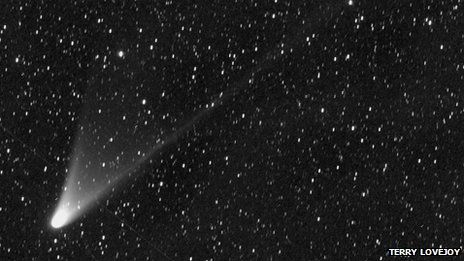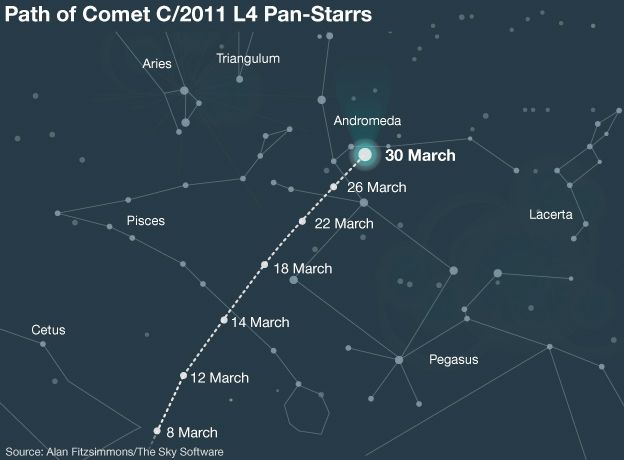By Rebecca Morelle,
Science reporter, BBC World Service
 (This image of the comet was made when it was visible in the Southern Hemisphere, but now those in the Northern Hemisphere should get a chance to see the icy mass)
Stargazers could enjoy a rare spectacle as a bright comet swings into the Northern Hemisphere
(This image of the comet was made when it was visible in the Southern Hemisphere, but now those in the Northern Hemisphere should get a chance to see the icy mass)
Stargazers could enjoy a rare spectacle as a bright comet swings into the Northern Hemisphere.
The icy mass, called C/2011 L4 Pan-Starrs, should be visible with binoculars or a telescope from 8 March.
But in the following days, it will become even brighter and could be seen with the naked eye.
Astronomers in the Southern Hemisphere have already been treated to a fly past, with reports that the body was as bright as stars in the Plough.
Mark Bailey, director of the Armagh Observatory in Northern Ireland, said: "We have great hopes for this comet. Of course we are always very cautious - even now we don't know how bright it is going to get - but we are keeping out fingers crossed."
Once in a lifetime
The comet was first discovered in June 2011, spotted by the Pan-Starrs telescope (hence its name) in Hawaii as a faint object more than a billion kilometres away.
Astronomers believe it originated in the Oort Cloud, a region of space packed full of comets, and has been hurtling towards the Sun for millions of years.
It is thought to be a non-periodic comet, which means this could be the first time it has ever passed through the inner Solar System, and it might not return for another 100,000 years.
On 10 March, it will make its closest approach to the Sun, passing at a distance of about 45 million kilometres.
As it heats up, the ice and dust in the Pan-Starrs' outer crust turn to gas, making it bright in the night sky. Solar wind and pressure from sunlight gives the body its characteristic double tail.
Prof Bailey said: "The closer you get to the Sun, the more of this material is ejected, and therefore the brighter the comet can be."
He said that the nucleus of the comet was estimated to be about 20-30km in diameter, but the gas and dust surrounding meant it could span more than a million kilometres.
 (The comet will appear to move through the constellations of Pisces, Pegasus and Andromeda)
(The comet will appear to move through the constellations of Pisces, Pegasus and Andromeda)
The 12 and 13 March could provide the best viewing opportunity. At this time, it will move further from the Sun, but should be easier to spot in the night sky, providing it is a clear night.
"After sunset, scan the horizon roughly in the western direction. On the 12 and 13 March, there is a nice association with the thin crescent Moon," advised Prof Bailey.
"You can use the Moon as a guide, and search just down or to the left of the Moon. Through binoculars you should be able to see the head of the comet and certainly the two types of the tail."
He added: "I would always advise people to hunt for comets with binoculars, but if you have found it with binoculars, have a good hunt around and see if you can see it with the naked eye. That's quite a challenge - but it is a wonderful thing to have seen."
After this, the comet will begin to appear later and higher up in the night sky. And then, as April draws near, it will vanish back into the depths of space where it can only be seen with large telescopes.
If the weather proves poor during this period, astronomers could be offered another chance for a celestial delight at the end of the year when comet Ison should grace our skies.
Flying four times closer to the Sun than Pan-starrs, it could prove even brighter. But there is also a chance that it could break up.